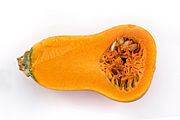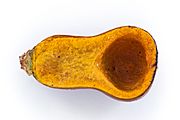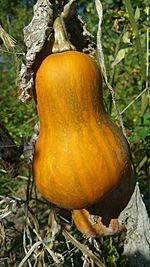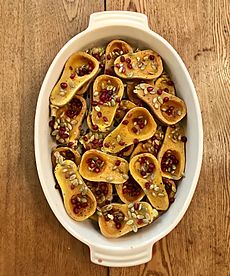Honeynut squash facts for kids
Quick facts for kids Cucurbita 'Honeynut' |
|
|---|---|
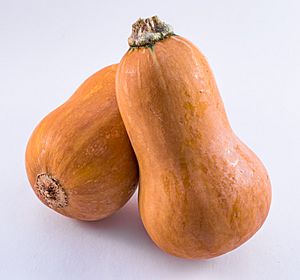
Ripe honeynut squash
|
|
| Genus | Cucurbita |
| Hybrid parentage | C. moschata × C. maxima |
| Cultivar | 'Honeynut' |
| Breeder | Michael Mazourek, Richard W. Robinson |
| Origin | 1980s in Geneva, New York |
Honeynut squash is a special type of winter squash. It was created by mixing two other squashes: butternut and buttercup. It looks a lot like butternut squash but is about half the size. Honeynut squash is also much sweeter.
This squash has dark tan or orange skin and bright orange inside. When it's ready to eat, its skin changes from green to a deep orange. This color change also means it's getting sweeter! Honeynut squash has a lot of beta-carotene, which is good for you. It has two to three times more than butternut squash.
Even though it's technically a fruit, people use honeynut squash like a vegetable. You can roast it, cook it in soups, or even use it in sweet desserts.
The first ideas for this squash came from Richard W. Robinson in the 1980s. He was a professor at Cornell University. Later, around 2006, another Cornell professor, Michael Mazourek, worked on it. He helped bring Honeynut squash to stores in the USA by 2015. He worked with Dan Barber, a famous chef. They are still working on new types of squash today!
Contents
Discovering Honeynut Squash
Honeynut squash was made by carefully mixing butternut (Cucurbita moschata) and buttercup (C. maxima) squashes. It has the classic bell shape of a butternut squash, but it's smaller. The skin is darker and thinner, and you can even eat it!
The skin is a deep tan or orange color, sometimes called "honey-colored." This color, along with its sweet taste, gave the squash its name. A cool thing about Honeynut squash is how its color changes as it grows. For most of its eight-week growing time, it stays deep green. Then, in the last few weeks, it turns that honey color right on the vine.
The inside of the squash is firm, moist, and smooth. It has a small part with seeds at the bottom. Honeynut squash tastes stronger and sweeter than butternut squash. It also has a nutty flavor. These squashes are usually about 2.5 to 4 inches (6 to 10 cm) wide. They are also about 4 to 5 inches (10 to 13 cm) long. Butternut squashes are much bigger, usually 10 to 11 inches (25 to 28 cm) long.
Honeynut squash grows on a vine that doesn't spread out too much. It takes about 105 to 110 days for the squash to grow from a seed. Farmers plant them in May and pick them in late September or early October.
You can store Honeynut squash in a cool, dry place for about a month. It's best to eat them when they start to look a little wrinkled. This means they are drying out. Because their skin is thin, they don't store as long as other winter squashes. For example, butternut squash can last for two or three months. Once you peel or cut Honeynut squash, you can keep it in the fridge for up to a week. You can also freeze it for up to three months.
You can find Honeynut squash in many grocery stores and farmer's markets. Stores like Whole Foods, Trader Joe's, and Costco sell them. You might also find them in meal kits from companies like Blue Apron.
Healthy Benefits
Honeynut squash is super good for you! It's an excellent source of vitamin A and beta-carotene. Remember, it has two to three times more beta-carotene than butternut squash. This squash also gives you B vitamins, calcium, copper, iron, and potassium. It's a great way to get important nutrients.
The Story of Honeynut Squash
The idea for Honeynut squash started in the 1980s. Richard W. Robinson, a professor at Cornell University, began experimenting. He crossed a buttercup and a butternut squash in Geneva, New York. But his first squash didn't make it to stores.
Years later, Michael Mazourek, another plant breeder at Cornell, picked up the project. His advisor encouraged him to create new plants for people to enjoy. Mazourek improved Robinson's squash by using special plant breeding methods. He worked with a local farmer in 2006 to test his new squash seeds.
In 2009, a farm called Stone Barns Center for Food & Agriculture invited Cornell plant breeders. The farm's director asked Dan Barber, a chef at the farm's restaurant Blue Hill, to cook the new plants. After dinner, Chef Barber challenged Mazourek. He asked, "Why don't you make this thing taste good? Why don't you shrink the thing?!"
Mazourek had been working on the Honeynut squash for about a year. But seed companies and farmers didn't think smaller squash would sell well. They usually wanted bigger squash for more yield. Chef Barber's question made Mazourek think about flavor more than just size.
To make the Honeynut squash better, Mazourek crossed two similar squashes. Then he planted the seeds and picked the best ones. He looked for squash with the best color, size, and texture. Chef Barber helped by cooking and tasting the squash. He roasted them at high heat, which made them sweeter and more flavorful. Before this, Mazourek had usually microwaved or steamed squash. This added water and made the flavor weaker.
Chef Barber started promoting the Honeynut squash at his restaurant. He also showed it to top chefs from around the world in 2013. Famous chefs like René Redzepi and Massimo Bottura loved it! It took about two and a half years for the squash to reach stores, finally arriving in 2015. That year, Saveur magazine featured it as a new and popular food.
Soon, many farms in the Northeast United States started growing Honeynut squash. By 2017, about 90 percent of squash farms in that area grew it! Now, you can find it in stores and markets all over the country.
The talk between Mazourek and Barber also led them to start a seed company called Row 7 Seed Co. They sell special seeds for gourds and other plants. They are now working on an even smaller squash called 898 Squash. It will have a longer season, grow more squash, and have slightly thicker skin. This thicker skin will help it stay fresh longer in storage. The 898 Squash is expected to take at least five more years to develop.
Cooking with Honeynut Squash
Honeynut squash is perfect for roasting and stuffing. It's also sweet enough to use in desserts. You can bake it, boil it, mash it, or add it to soups and stews. It works well in most recipes that call for butternut or other winter squashes.
When you roast Honeynut squash at high heat, its natural sugars turn into a rich, caramel flavor. The skin is thin, so you can eat it! Plus, it's small enough for one person, which makes it super easy and fast to prepare.
Honeynut squash tastes great with many other foods. Some good pairings include kale, miso, green apples, pine nuts, farro, garlic, onion, and herbs like thyme and sage. It also goes well with cinnamon, black beans, Parmesan cheese, mushrooms, corn, maple syrup, and honey.


